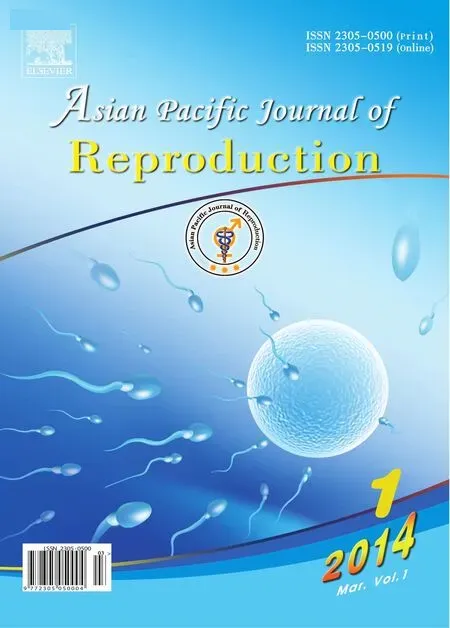H7N9 influenza and its impact on pregnancy
Viroj Wiwanitkit
1Faculty of Medicine, University of Nis, Serbia
2Hainan Medical University, China
3Joseph Ayobabalola University, Nigeria
4Chulalongkorn University, Thailand
H7N9 influenza and its impact on pregnancy
Viroj Wiwanitkit
1Faculty of Medicine, University of Nis, Serbia
2Hainan Medical University, China
3Joseph Ayobabalola University, Nigeria
4Chulalongkorn University, Thailand
ARTICLE INFO
Article history:
Received 6 June 2013
Received in revised form 12 October 2013 Accepted 13 November 2013
Available online 20 January 2014
H7N9
This short article specifically focuses on the new emerging H7N9 influenza which has just been observed since early 2013. As a new disease, it is lack for the knowledge on the new H7N9 influenza. Here, the author will discuss on the impact of emerging H7N9 influenza on pregnancy.
1. Introduction to new H7N9 bird flu
New emerging disease is a concern in public health. The cross species atypical H7N9 influenza virus infection originating in China is a big global problem at present [1 - 2]. As a new atypical influenza, the great fear is on the worldwide epidemic as previously seen in the previous outbreak on atypical influenza infections, H5N1 bird fu [3] and H1N1 swine flu [4].
Of interest, although H7N9 influenza causes respiratory illness, additional atypical manifestations can also be seen [5-7]. Since its first emerging in China, upto 130 cases has been accumulated (30 May 2013).
This short article specifically focuses on the new emerging H7N9 influenza which has just been observed since early 2013. As a new disease, it is lack for the knowledge on the new H7N9 influenza. Here, the author will discuss on the impact of emerging H7N9 influenza on pregnancy.
2. New H7N9 influenza infection in pregnant patients
The new H7N9 influenza can infect anyone, in any age group and sex [5-6]. As a disease resulted from genetic alteration [8-9], the pathobiological process due to the infection might be different from classical influenza can be expected. It is useful to gathering the data of this specific new infection. In obstetrics, the data of this new infection is highly required.
Focusing on the pregnant, only a few reports are available for H7N9 influenza. Nevertheless, it is no doubt that pregnant patients are at risk for get severe influenza [10]. For the new emerging bird flu, the severe illness can be seen. The good example is the previous situation in outbreak of H1N1 swine flu [11] and H5N1 bird flu [12]. For the presentH7N9 influenza, there is only 1 pregnant patient from overall 130 cases (30 May 2013). The case is a 25 year old patient identified in Jiangsu Province in 30 March 2013. According to the record, this patient did not have serious infection and the recovery could be seen. There is no obstetrical complication. Nevertheless, there is still no data on the fetus and infant (still not birth at present).
3. Prevention of H7N9 influenza in the pregnancy
The prevention of influenza is an important in preventive obstetrics. Generally, influenza vaccination is recommended for the pregnant [13]. However, as a new infection, no vaccine for H7N9 influenza is available at present. Although the pregnant is classified as a risk group, the antiviral prophylaxis is not recommended.
Conflict of interest statement
We declare that we have no conflict of interest
[1] Bush RM. Influenza as a model system for studying the crossspecies transfer and evolution of the SARS coronavirus. Philos Trans R Soc Lond B Biol Sci 2004; 359: 1067-1073.
[2] Sansonetti P. How to define the species barrier to pathogen transmission? Bull Acad Natl Med 2006; 190: 611-622.
[3] Trampuz A, Prabhu RM, Smith TF, Baddour LM. Avian influenza: a new pandemic threat? Mayo Clin Proc 2004; 79: 523-530.
[4] Vincent AL, Ma W, Lager KM, Janke BH, Richt JA. Swine influenza viruses a North American perspective. Adv Virus Res 2008; 72: 127-154.
[5] Centers for Disease Control and Prevention (CDC). Emergence of Avian Influenza A(H7N9) Virus Causing Severe Human Illness -China, February-April 2013. MMWR Morb Mortal Wkly Rep 2013; 62(18): 366-371.
[6] Tang RB, Chen HL. An overview of the recent outbreaks of the avian-origin influenza A (H7N9) virus in the human. J Chin Med Assoc 2013; 76(5): 245-248
[7] Kageyama T, Fujisaki S, Takashita E, Xu H, Yamada S, Uchida Y, et al. Genetic analysis of novel avian A(H7N9) influenza viruses isolated from patients in China, February to April 2013. Euro Surveill 2013; 18(15): 20453.
[8] Bertran K, Pérez-Ramírez E, Busquets N, Dolz R, Ramis A, Darji A, et al. Pathogenesis and transmissibility of highly (H7N1) and low (H7N9) pathogenic avian influenza virus infection in red-legged partridge (Alectoris rufa). Vet Res 2011; 42(1): 24.
[9] Pasick J, Pedersen J, Hernandez MS. Avian influenza in North America, 2009-2011. Avian Dis 2012; 56(4 Suppl): 845-848.
[10] Cantu J, Tita AT. Management of influenza in pregnancy. Am J Perinatol 2013; 30(2): 99-103.
[11] Wiwanitkit V. Obstetrical concern on new emerging swine flu. Arch Gynecol Obstet 2010; 281(2): 369.
[12] Wiwanitkit V. No evidence of gynecological and obstetrical manifestation in H5N1 influenza virus infection. Arch Gynecol Obstet 2009; 279(4): 609.
[13] Nitsch-Osuch A, Wo?niak Kosek A, Brydak LB. Vaccination against influenza in pregnant women - safety and effectiveness. Ginekol Pol 2013; 84(1): 56-61.
ment heading
10.1016/S2305-0500(14)60008-7
*Corresponding author: Professor Viroj Wiwanitkit Wiwanitkit House, Bangkhae, Bangkok, Thailand.
E-mail: wviroj@yahoo.com
Influenza Pregnancy
 Asian Pacific Journal of Reproduction2014年1期
Asian Pacific Journal of Reproduction2014年1期
- Asian Pacific Journal of Reproduction的其它文章
- Tuberculous orchitis mimicking a testicular tumor: A diagnostic dilemma
- Klinefelter syndrome and its association with male infertility
- Current insights into gonadotropic pituitary function in the polycystic ovary syndrome
- Investigation on leukocyte profile of periparturient cows with or without postpartum reproductive disease
- Tranexamic acid reduces blood loss during and after cesarean section: A double blinded, randomized, controlled trial
- Maternal outcome in multiple versus singleton pregnancies in Northern Tanzania: A registry-based case control study
